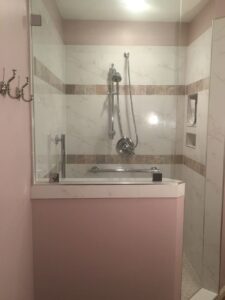Downsizing for Seniors or a choice to Assisted Living Situations
Enjoying their day in a quiet park setting

Contributing author: Mike Longsdon; Edited by: Peggy White Golden, ASID
It’s not easy to accept all of the complications associated with older age. Whether problems are mental or physical, most seniors face a point where it is not possible to continue living in their home especially if they are alone. Instead of forced transitioning to an assisted living facility, seniors may consider downsizing earlier than when necessitated while they have a choice of where to live more comfortably in a safer environment. Downsizing to a smaller, more manageable home comes with many advantages. Listed here are some helpful ideas for an aging parent(s) and their supportive children to assist with a smoother transition when downsizing.
Advantages of Downsizing
Smaller properties are more affordable in all aspects including rent, property taxes, and utilities. This extra money can be put toward medical bills, savings or visits to see out of town grandchildren. Smaller well designed homes for senior life benefit from greater accessibility, as everything is in close proximity and considerations have been thought of for ease of use and mobility. Flooring materials are specified to eliminate tripping hazards and hard surface flooring materials (ie: tile, sold wood) are replaced with faux vinyl wood flooring for softer landings in case of a fall.

Bathrooms have more room, toilets and sinks/faucets have ADA safe features. Showers are designed with no threshold or very low thresholds for ease of entering and exiting without a tripping hazard. Grab bars are placed strategically for protection from falls.
Kitchen appliances are smaller and simpler for operation with safety features. Faucets can be motion sensor operation with anti-scald features. Many new IOT devices can be incorporated for turning on/off light fixtures, opening shades and blinds at sunrise and sunset and turning on the coffee maker.
In general, smaller homes are easier to manage and care for in terms of cleaning, lawn maintenance, and organization. As HomeAdvisor explains, “Having fewer financial- and maintenance – related responsibilities will allow you to focus more on your happiness and less on your home.”

Getting Rid of Larger and Unused Items
When moving into a new home, seniors have the unique problem of sifting through decades worth of belongings they have accumulated over time. It is not practical or possible to keep everything when moving into a smaller property providing a great time to determine valuable items from non-essential and begin the decluttering phase. The decluttering process is difficult and emotional, especially when deciding which items to discard. A good place to start is getting rid of anything too large or unused. Larger items, like extra couches or massive tables that take up too much room, can be dangerous and will make a smaller home feel even smaller. Items that don’t receive much use at all should be thrown away or donated. Photographs and sentimental items should be pared down to a single keepsake box. Performing this task early is easier to accomplish with time on your side to process the throwing away and discarding of items. Consider tackling a room at a time over a few months for less disruption to the senior watching their life possessions disappear.
Transitioning to a new home is emotional and challenging for the senior(s). With an upbeat attitude adult children can persuade the senior(s) to depart with older soft seatings in favor of purchasing new smaller sized pieces designed for elder comfort. Recliners with a lift-assist feature; sofas can be sized to the right seat height, seat depth with firmer seat cushions making it easier for the older person to get up from. Newer coffee tables are 18-19” height making reach more accessible, there are even motorized coffee tables allowing the height to be work or eating level with the push of a button.
Finding the Perfect Home
There are many factors to consider when searching for the perfect home size and location. Whether you purchase a smaller home or opt to rent it is best to have a ground level entry with one level living. Stairs are impossible for some seniors to maneuver and even if your parents have good mobility when you transition them to a smaller place they will develop mobility issues as they age. Although size is an important factor, you should make sure that the home is within a manageable price range and has minimal maintenance and upkeep. Location is key and if you find something located nearby friends, family, and medical facilities transitioning will be easier and less burdensome for the caretaker adults.
Prepare for a Smooth Moving Process
While picking the perfect home can be exciting, most people dread the idea of having to move all of their belongings. Fortunately, a little bit of preparation can make this transition smoother. It’s advisable to have a combination of professionals movers and help from people you know. You can ask friends and family to help with moving smaller items, while movers take care of larger pieces of furniture and other over-sized belongings. Every minute you prepare before the actual moving day is a minute that doesn’t have to be rushed. This will greatly reduce your stress and anxiety levels surrounding the move.
Moving away from a place you’ve called home for so many years is emotional. When downsizing as a senior while you are still physically fit can be a welcoming change in your daily life, most likely the move will bring many benefits you would not have realized. A smaller more manageable place with less upkeep, safe furnishings and accessibility fixtures and design concepts will make your life easier each day. With the right set-up, you could end up in a much better living situation than before even happier each day.
Photo Credit: Pixabay






